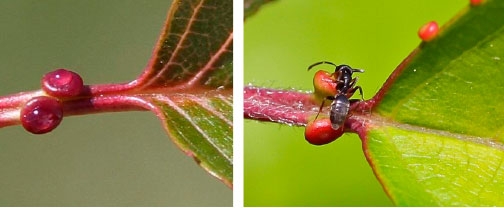We have discussed ants affecting plants negatively one way or another: taking nectar from flowers but failing to fertilise the plant; farming scale-insects and aphids, and defending them from their predators.
Ants, however, also have a mutualistic relationship with plants.
Plants utilise EFN (continued from last issue)
Take the cherry tree. As green cherries are growing, their young tender leaves are at their juiciest. Many caterpillars and other herbivorous insects would love to eat them.
But cherries have this sweet way to call for bodyguards: they secrete nectar in red floral glands at the base of each leaf—the extrafloral nectaries.
We see many ant nests in cherry trees, and ants moving around the shoots. The EFN are irresistible to ants and they secrete nectar in small quantities so ants are encouraged to scout around the tree to find the next leaf.
Should they encounter a caterpillar trying to get to the leaves, or an insect land on it, the ants act aggressively like they do to defend aphids or scale insects, and they keep the insects at bay.
Nectaries are produced by a large number of flowering plants. Experiments have demonstrated that if ants are excluded from a nectary–bearing plant, the plant is rapidly damaged by herbivorous insects.
This seasonal match between nectar production and caterpillar attack suggests that the main function of nectaries is as an ant attractant—as a deterrent from herbivorous caterpillars
Myrmecophile
For the budding botanists, the term myrmecophile means ant lover.
It is derived from the Greek myrmex = ant, and phlos = loving. The term applies to the special relationship some plants and animals, including insects (e.g. aphids) have with ants.
Obviously many plants in the Prunus genus, including cherries, are myrmecophiles with their sweet love expressed through EFN.
So next time you see a cherry tree have a look for the extrafloral nectaries (located on the leaf stalk and are very obvious). Maybe you can even find some ants or wasps drinking the nectar.
See this article in Tree Fruit August 2018




















